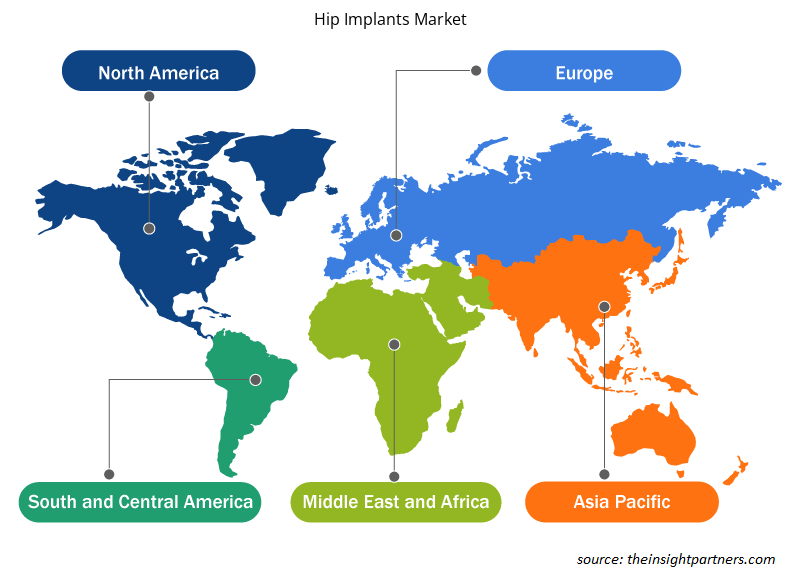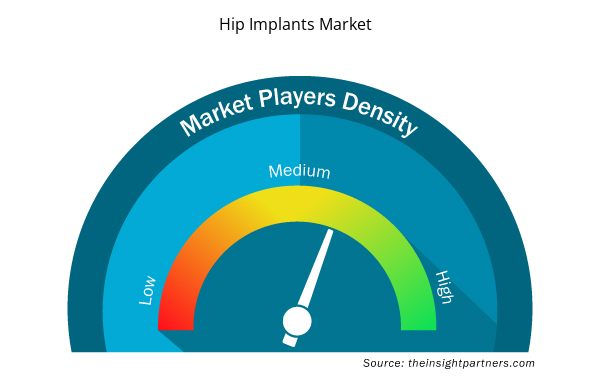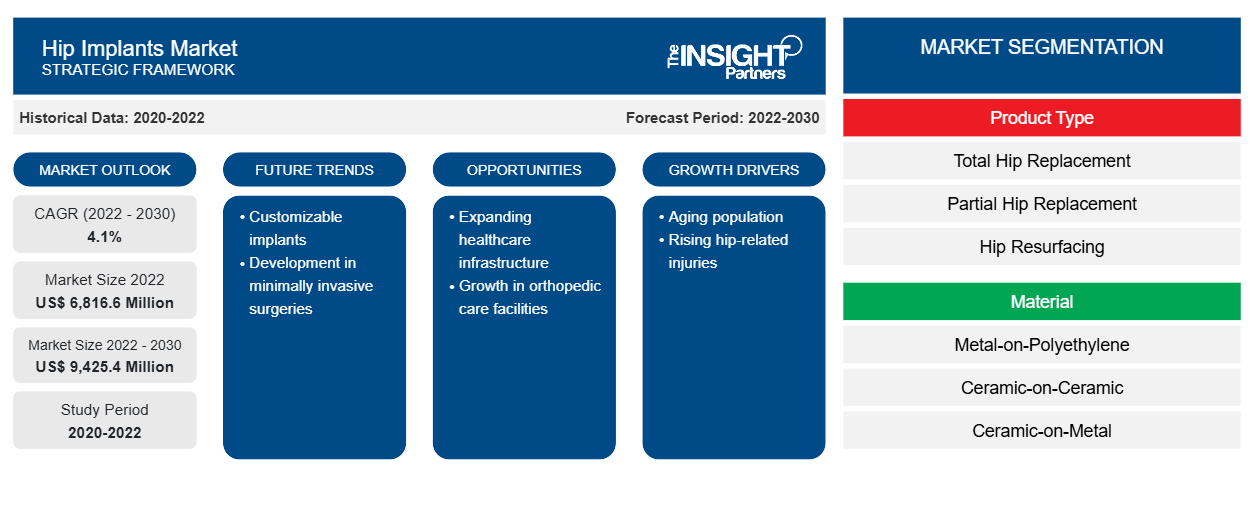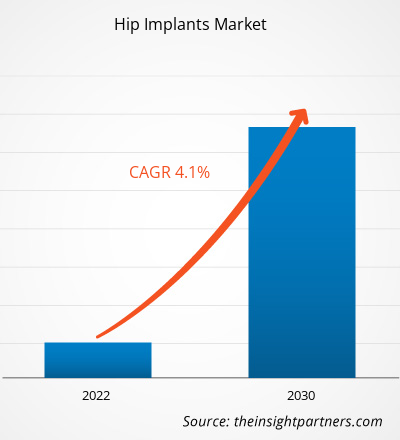[Informe de investigación] Se espera que el mercado de implantes de cadera crezca de US$ 6.816,6 millones en 2022 a US$ 9.425,4 millones en 2030; se anticipa que registre una CAGR del 4,1% entre 2022 y 2030.
Perspectivas del mercado y opinión de analistas:
El tamaño del mercado de implantes de cadera está creciendo rápidamente debido al aumento de las cirugías de cadera, las lesiones de cadera, la osteoartritis y la artritis reumatoide. Además, las iniciativas estratégicas de las empresas para mantenerse competitivas están impulsando el crecimiento del mercado. Por ejemplo, Smith & Nephew lanzó el sistema de movilidad dual OR3O en India en agosto de 2023 para la artroplastia de cadera primaria y de revisión. OR3O incluye la superficie de apoyo avanzada de Smith & Nephew, OXINIUM DH, debido a su revestimiento y OXINIUM patentado en XLPE. Esto elimina tanto el revestimiento modular de CoCr como la bola de la cabeza de CoCr de la construcción, lo que reduce los riesgos de desgaste y corrosión asociados con la aleación. Por lo tanto, es probable que un aumento significativo de las tecnologías revolucionarias para abordar las necesidades de los clientes traiga nuevas tendencias en el pronóstico del mercado de implantes de cadera.
Factores impulsores del crecimiento y desafíos:
Según la Osteoarthritis Action Alliance, la osteoartritis es una de las formas más comunes de artritis en los EE. UU. y afecta a casi 32,5 millones de personas, de las cuales el 43 % de la población tenía más de 65 años en 2020. Según los Centros para el Control y la Prevención de Enfermedades, alrededor del 23 % de la población de EE. UU. tenía artritis en 2020. Según Arthritis Research Canada, se estima que más de 6 millones de canadienses tienen osteoartritis, y se proyecta que serán 10,5 millones para 2040. La osteoartritis puede provocar lesiones y fracturas de cadera, ya que la densidad ósea en los pacientes con artritis es menor que en los que no la tienen.
La Organización Mundial de la Salud (OMS) estimó que la población mayor de 60 años era de 1.000 millones en 2019, y se prevé que alcance los 1.400 millones en 2030 y los 2.100 millones en 2050. Se prevé que la proporción de población geriátrica aumente del ~15% al ~24% durante este período. Según otro informe de Eurostat, Europa tenía el porcentaje más alto del mundo (20,8%) de personas mayores de 60 años en 2021. Además, para 2050, en todas las regiones excepto África, más del 25% de sus poblaciones habrán superado los 60 años. Por lo tanto, el aumento de la población geriátrica ha impulsado la prevalencia de diversas afecciones ortopédicas, como lesiones de cadera, osteoartritis y dislocación de cadera debido a caídas y otros incidentes desafortunados, lo que resulta en un crecimiento del mercado de implantes de cadera.
Personalice este informe según sus necesidades
Obtendrá personalización en cualquier informe, sin cargo, incluidas partes de este informe o análisis a nivel de país, paquete de datos de Excel, así como también grandes ofertas y descuentos para empresas emergentes y universidades.
- Obtenga las principales tendencias clave del mercado de este informe.Esta muestra GRATUITA incluirá análisis de datos, desde tendencias del mercado hasta estimaciones y pronósticos.
Segmentación y alcance del informe:
El mercado de implantes de cadera se divide en función del tipo de producto, el material, el usuario final y la geografía. Por tipo de producto, el mercado se segmenta en reemplazo total, reemplazo parcial, recubrimiento de cadera e implantes de revisión de cadera. Por material, el mercado se segmenta en metal sobre polietileno, cerámica sobre cerámica, cerámica sobre metal, cerámica sobre polietileno y otros. Por usuario final, el mercado se segmenta en hospitales, clínicas ortopédicas, centros quirúrgicos ambulatorios y otros. Según la geografía, se divide en América del Norte (EE. UU., Canadá y México), Europa (Reino Unido, Alemania, Francia, Italia, España, Rusia y el resto de Europa), Asia Pacífico (China, Japón, India, Corea del Sur, Australia y el resto de Asia Pacífico), Oriente Medio y África (EAU, Arabia Saudita, Sudáfrica y el resto de Oriente Medio y África) y América del Sur y Central (Brasil, Argentina y el resto de América del Sur y Central).
Análisis segmental:
El análisis del mercado de implantes de cadera, por tipo de producto, se segmenta en reconstrucción femoral, reconstrucción acetabular, recubrimiento de cadera, implantes de revisión de cadera, tecnologías de cojinetes y metales porosos e implantes de reemplazo total. En 2022, el segmento de implantes de reemplazo total tuvo la mayor participación de mercado de implantes de cadera y se espera que registre la CAGR más alta durante 2022-2030.
Por material, el mercado está segmentado en metal sobre polietileno, cerámica sobre cerámica, cerámica sobre metal y cerámica sobre polietileno. En 2022, el segmento de metal sobre plástico tuvo la mayor participación de mercado de implantes de cadera y se espera que registre la CAGR más alta en el pronóstico del mercado de implantes de cadera de 2022 a 2030. El crecimiento del segmento está impulsado por beneficios como resultados precisos, durabilidad y rentabilidad. Además, otros beneficios, como menos complicaciones, avances tecnológicos y menos partículas de desgaste, impulsan la demanda de implantes de cadera basados en metal sobre plástico.
Por usuario final, el mercado está segmentado en hospitales, clínicas ortopédicas, centros quirúrgicos ambulatorios y otros. En 2022, el segmento hospitalario tuvo la mayor participación de mercado de implantes de cadera y se espera que registre la CAGR más alta durante 2022-2030. El creciente número de cirugías de implantes de cadera en los hospitales está impulsando el crecimiento del segmento de implantes de cadera en todo el mundo. Además, el personal del hospital está bien capacitado y es consciente de las complicaciones que pueden ocurrir durante o después del tipo de cirugía. El personal del hospital está capacitado para abordar emergencias y brindar una atención equilibrada al paciente. Los procedimientos de reembolso por cirugías también están fácilmente disponibles y pueden ser administrados por la administración del hospital. Además, el creciente número de hospitales en todo el mundo probablemente mantendrá el dominio del segmento y aprovechará el crecimiento del mercado de implantes de cadera durante el período de pronóstico. Además, el creciente número de hospitales en todo el mundo probablemente mantendrá el dominio del segmento.
Análisis regional:
Geográficamente, el informe del mercado de implantes de cadera se divide en América del Norte, Europa, Asia Pacífico, Oriente Medio y África, y América del Sur y Central. América del Norte es el mayor contribuyente al crecimiento del mercado mundial de implantes de cadera. Se prevé que Asia Pacífico muestre la CAGR más alta en el pronóstico del mercado de implantes de cadera de 2022 a 2030. La creciente incidencia de implantes de cadera, lanzamientos de productos y lesiones deportivas de cadera impulsan principalmente el crecimiento del mercado en los EE. UU. Según el artículo "Hip Fracture Care and National Systems", publicado por Wolters Kluwer Health, Inc., alrededor de 250.000 a 300.000 personas en los EE. UU. Son hospitalizadas por fracturas de cadera anualmente. También se estima que alrededor de 500.000 personas serán atendidas por profesionales médicos debido a fracturas de cadera para 2040. Según la Academia Estadounidense de Cirujanos Ortopédicos, las personas de 65 años o más son propensas a sufrir fracturas de cadera debido a caídas en el hogar o la comunidad en los EE. UU. Según el artículo “Hip Overview” publicado en National Library Medicine, los pacientes gastan aproximadamente 40.000 dólares estadounidenses durante el primer año después de una fractura de cadera y el coste total de la atención de la fractura de cadera en los EE. UU. asciende a casi 17.000 millones de dólares estadounidenses al año. Por lo tanto, la creciente prevalencia de fracturas y lesiones de cadera en los EE. UU. y el aumento del gasto en el tratamiento de estas lesiones son la tendencia actual del mercado de implantes de cadera en los EE. UU.
Perspectivas regionales del mercado de implantes de cadera
Los analistas de Insight Partners explicaron en detalle las tendencias y los factores regionales que influyen en el mercado de implantes de cadera durante el período de pronóstico. Esta sección también analiza los segmentos y la geografía del mercado de implantes de cadera en América del Norte, Europa, Asia Pacífico, Oriente Medio y África, y América del Sur y Central.

- Obtenga datos regionales específicos para el mercado de implantes de cadera
Alcance del informe de mercado sobre implantes de cadera
| Atributo del informe | Detalles |
|---|---|
| Tamaño del mercado en 2022 | US$ 6.816,6 millones |
| Tamaño del mercado en 2030 | US$ 9.425,4 millones |
| CAGR global (2022-2030) | 4,1% |
| Datos históricos | 2020-2022 |
| Período de pronóstico | 2022-2030 |
| Segmentos cubiertos | Por tipo de producto
|
| Regiones y países cubiertos | América del norte
|
| Líderes del mercado y perfiles de empresas clave |
|
Densidad de actores del mercado de implantes de cadera: comprensión de su impacto en la dinámica empresarial
El mercado de implantes de cadera está creciendo rápidamente, impulsado por la creciente demanda de los usuarios finales debido a factores como la evolución de las preferencias de los consumidores, los avances tecnológicos y una mayor conciencia de los beneficios del producto. A medida que aumenta la demanda, las empresas amplían sus ofertas, innovan para satisfacer las necesidades de los consumidores y aprovechan las tendencias emergentes, lo que impulsa aún más el crecimiento del mercado.
La densidad de actores del mercado se refiere a la distribución de las empresas o firmas que operan dentro de un mercado o industria en particular. Indica cuántos competidores (actores del mercado) están presentes en un espacio de mercado determinado en relación con su tamaño o valor total de mercado.
Las principales empresas que operan en el mercado de implantes de cadera son:
- Smith y sobrino
- Tecnología exacta
- Biomet de Zimmer
- Corporación Stryker
- DJO Quirúrgico (Enovis)
Descargo de responsabilidad : Las empresas enumeradas anteriormente no están clasificadas en ningún orden particular.

- Obtenga una descripción general de los principales actores clave del mercado de implantes de cadera
Desarrollos industriales y oportunidades futuras:
A continuación se enumeran varios planes de los actores clave que operan en el mercado de implantes de cadera:
- En agosto de 2022, Exatech lanzó comercialmente un novedoso sistema de artroplastia total de cadera que consta de Spartan Stem y Logical Cup. El Spartan Hip Stem refleja las necesidades contemporáneas de los pacientes y los últimos avances en el abordaje quirúrgico. Logical Cup es un sistema acetabular modular avanzado diseñado para satisfacer las demandas de pacientes altamente activos y, al mismo tiempo, permitir un proceso quirúrgico eficiente en hospitales y centros quirúrgicos ambulatorios.
- Smith & Nephew lanzó el sistema de movilidad dual OR3O en septiembre de 2022 para artroplastias de cadera primarias y de revisión en Japón. Esta superficie de apoyo avanzada, OXINIUM DH, se utiliza para su OXINIUM lineal y patentado sobre XLPE para sus insertos de polietileno y cabeza femoral.
Panorama competitivo y empresas clave:
Algunos de los actores destacados que se incluyen en el informe sobre el mercado de implantes de cadera son Smith & Nephew, Exactech, Zimmer Biomet, Stryker Corporation, DJO Surgical (Enovis), Medacta, Conformis, DePuy Orthopaedics, MicroPort Orthopaedics y Symbios. Estas empresas se centran en las expansiones geográficas y los lanzamientos de nuevos productos para satisfacer la creciente demanda de los consumidores de todo el mundo y aumentar su gama de productos en carteras especializadas. Su presencia global les permite atender a una gran base de clientes, lo que facilita la expansión del mercado.
- Análisis histórico (2 años), año base, pronóstico (7 años) con CAGR
- Análisis PEST y FODA
- Tamaño del mercado Valor/volumen: global, regional, nacional
- Industria y panorama competitivo
- Conjunto de datos de Excel


- Bio-Based Ethylene Market
- Excimer & Femtosecond Ophthalmic Lasers Market
- Pressure Vessel Composite Materials Market
- Broth Market
- Formwork System Market
- Advanced Planning and Scheduling Software Market
- Print Management Software Market
- Aircraft Landing Gear Market
- Virtual Event Software Market
- HVAC Sensors Market

Report Coverage
Revenue forecast, Company Analysis, Industry landscape, Growth factors, and Trends

Segment Covered
This text is related
to segments covered.

Regional Scope
North America, Europe, Asia Pacific, Middle East & Africa, South & Central America

Country Scope
This text is related
to country scope.
Preguntas frecuentes
The hip implants market, by product type, is segmented into total replacement implants, partial total replacement implants, hip resurfacing, and revision hip implants. In 2022, the total replacement implants segment held the largest market share and is expected to record the highest CAGR during 2022–2030.
The hip implants market, by material, is segmented into metal-on-polyethylene, ceramic-on-ceramic, ceramic-on-metal, and ceramic-on-polyethylene and others. 2022 the metal-on-plastic segment held the largest market share and is expected to record the highest CAGR from 2022 to 2030.
The hip implants market, by end-user, is segmented into hospitals, orthopedic clinics, ambulatory surgical centers, and others. In 2022, the hospital segment held the largest market share and is expected to record the highest CAGR during 2022–2030.
The hip implants market majorly consists of players such Smith & Nephew, Exactech, Zimmer Biomet, Stryker Corporation, DJO Surgical (Enovis), Medacta, Conformis, DePuy Orthopaedics, MicroPort Orthopedics, and Symbios.
The hip implants market size is largely driven by the increasing number of hip injuries and related diseases, and strategic initiatives in hip implants. However, the high cost of hip implants hinders the growth of the hip implant market.
Based on geography, the hip implants market is segmented into North America (the US, Canada, and Mexico), Europe (the UK, Germany, France, Italy, Spain, and the Rest of Europe), Asia Pacific (China, Japan, India, South Korea, Australia, and the Rest of Asia Pacific), the Middle East & Africa (the UAE, Saudi Arabia, South Africa, and Rest of the Middle East & Africa), and South & Central America (Brazil, Argentina, and the Rest of South & Central America). North America is the largest contributor to the growth of the global hip implants market. Asia Pacific is expected to register the highest CAGR in the hip implants market from 2022 to 2030.
Hip implants are medical devices designed to restore mobility and alleviate pain, usually associated with arthritis and other hip diseases or injuries. Every hip implant has its benefits and risks. Every hip implant system has unique device design features such as size, shape, material, and dimensions. In addition, the same hip implant system may have different outcomes in different patients. In addition, strategic initiatives by companies to stay competitive in the market are fueling market growth. For instance, Smith & Nephew launched the OR3O Dual Mobility System in August 2023 for use in primary and revision hip arthroplasty in India. OR3O includes Smith & Nephew’s advanced bearing surface, OXINIUM DH, due to its liner and proprietary OXINIUM on XLPE. This eliminates both the modular CoCr liner and/or CoCr head ball from the construct, which reduces wear and corrosion risks associated with the alloy. Thus, a significant rise in revolutionary technologies to address customer needs is likely to bring new trends in the market during the forecast period.
Trends and growth analysis reports related to Life Sciences : READ MORE..
The List of Companies - Hip Implants Market
- Smith & Nephew
- Exactech
- Zimmer Biomet
- Stryker Corporation
- DJO Surgical (Enovis)
- Medacta
- Conformis
- DePuy Orthopaedics
- MicroPort Orthopedics
- Symbios
The Insight Partners performs research in 4 major stages: Data Collection & Secondary Research, Primary Research, Data Analysis and Data Triangulation & Final Review.
- Data Collection and Secondary Research:
As a market research and consulting firm operating from a decade, we have published and advised several client across the globe. First step for any study will start with an assessment of currently available data and insights from existing reports. Further, historical and current market information is collected from Investor Presentations, Annual Reports, SEC Filings, etc., and other information related to company’s performance and market positioning are gathered from Paid Databases (Factiva, Hoovers, and Reuters) and various other publications available in public domain.
Several associations trade associates, technical forums, institutes, societies and organization are accessed to gain technical as well as market related insights through their publications such as research papers, blogs and press releases related to the studies are referred to get cues about the market. Further, white papers, journals, magazines, and other news articles published in last 3 years are scrutinized and analyzed to understand the current market trends.
- Primary Research:
The primarily interview analysis comprise of data obtained from industry participants interview and answers to survey questions gathered by in-house primary team.
For primary research, interviews are conducted with industry experts/CEOs/Marketing Managers/VPs/Subject Matter Experts from both demand and supply side to get a 360-degree view of the market. The primary team conducts several interviews based on the complexity of the markets to understand the various market trends and dynamics which makes research more credible and precise.
A typical research interview fulfils the following functions:
- Provides first-hand information on the market size, market trends, growth trends, competitive landscape, and outlook
- Validates and strengthens in-house secondary research findings
- Develops the analysis team’s expertise and market understanding
Primary research involves email interactions and telephone interviews for each market, category, segment, and sub-segment across geographies. The participants who typically take part in such a process include, but are not limited to:
- Industry participants: VPs, business development managers, market intelligence managers and national sales managers
- Outside experts: Valuation experts, research analysts and key opinion leaders specializing in the electronics and semiconductor industry.
Below is the breakup of our primary respondents by company, designation, and region:

Once we receive the confirmation from primary research sources or primary respondents, we finalize the base year market estimation and forecast the data as per the macroeconomic and microeconomic factors assessed during data collection.
- Data Analysis:
Once data is validated through both secondary as well as primary respondents, we finalize the market estimations by hypothesis formulation and factor analysis at regional and country level.
- Macro-Economic Factor Analysis:
We analyse macroeconomic indicators such the gross domestic product (GDP), increase in the demand for goods and services across industries, technological advancement, regional economic growth, governmental policies, the influence of COVID-19, PEST analysis, and other aspects. This analysis aids in setting benchmarks for various nations/regions and approximating market splits. Additionally, the general trend of the aforementioned components aid in determining the market's development possibilities.
- Country Level Data:
Various factors that are especially aligned to the country are taken into account to determine the market size for a certain area and country, including the presence of vendors, such as headquarters and offices, the country's GDP, demand patterns, and industry growth. To comprehend the market dynamics for the nation, a number of growth variables, inhibitors, application areas, and current market trends are researched. The aforementioned elements aid in determining the country's overall market's growth potential.
- Company Profile:
The “Table of Contents” is formulated by listing and analyzing more than 25 - 30 companies operating in the market ecosystem across geographies. However, we profile only 10 companies as a standard practice in our syndicate reports. These 10 companies comprise leading, emerging, and regional players. Nonetheless, our analysis is not restricted to the 10 listed companies, we also analyze other companies present in the market to develop a holistic view and understand the prevailing trends. The “Company Profiles” section in the report covers key facts, business description, products & services, financial information, SWOT analysis, and key developments. The financial information presented is extracted from the annual reports and official documents of the publicly listed companies. Upon collecting the information for the sections of respective companies, we verify them via various primary sources and then compile the data in respective company profiles. The company level information helps us in deriving the base number as well as in forecasting the market size.
- Developing Base Number:
Aggregation of sales statistics (2020-2022) and macro-economic factor, and other secondary and primary research insights are utilized to arrive at base number and related market shares for 2022. The data gaps are identified in this step and relevant market data is analyzed, collected from paid primary interviews or databases. On finalizing the base year market size, forecasts are developed on the basis of macro-economic, industry and market growth factors and company level analysis.
- Data Triangulation and Final Review:
The market findings and base year market size calculations are validated from supply as well as demand side. Demand side validations are based on macro-economic factor analysis and benchmarks for respective regions and countries. In case of supply side validations, revenues of major companies are estimated (in case not available) based on industry benchmark, approximate number of employees, product portfolio, and primary interviews revenues are gathered. Further revenue from target product/service segment is assessed to avoid overshooting of market statistics. In case of heavy deviations between supply and demand side values, all thes steps are repeated to achieve synchronization.
We follow an iterative model, wherein we share our research findings with Subject Matter Experts (SME’s) and Key Opinion Leaders (KOLs) until consensus view of the market is not formulated – this model negates any drastic deviation in the opinions of experts. Only validated and universally acceptable research findings are quoted in our reports.
We have important check points that we use to validate our research findings – which we call – data triangulation, where we validate the information, we generate from secondary sources with primary interviews and then we re-validate with our internal data bases and Subject matter experts. This comprehensive model enables us to deliver high quality, reliable data in shortest possible time.


 Obtenga una muestra gratuita de este informe
Obtenga una muestra gratuita de este informe